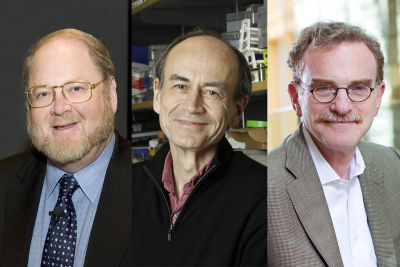
James E. Rothman, Thomas C. Südhof, and Randy W. Schekman
Last week James E. Rothman, Randy W. Schekman, and Thomas C. Südhof won the Nobel Prize in Physiology or Medicine “for their discoveries of machinery regulating vesicle traffic, a major transport system in our cells.” Dr. Rothman spent more than a decade of his career at Memorial Sloan Kettering, from 1991 to 2003, where he did much of his seminal research.
Dr. Rothman was Founding Chairman of the Cellular Biochemistry and Biophysics Program in the Sloan Kettering Institute and Vice Chairman of SKI. He left Memorial Sloan Kettering to establish a new center for chemical biology at Columbia College of Physicians and Surgeons, and later joined Yale University, where he is Wallace Professor of Biomedical Sciences and Professor and Chairman of Cell Biology.
What follows is an article about Dr. Rothman that appeared in the October 2002 issue of Center News magazine on the occasion of Dr. Rothman winning the Albert Lasker Award for Basic Research.
James E. Rothman, an investigator at Memorial Sloan Kettering since 1991, has received a 2002 Albert Lasker Award for Basic Research for his discoveries clarifying the universal mechanism by which vesicles — tiny sac-like structures that carry cargo such as proteins throughout cells — reach their correct destination and release their contents. This delivery process is vital for the growth and division of every cell, and how it happens had been one of the great, unsolved questions of cell biology.
“Jim Rothman’s research has answered some of the most fundamental questions about cell biology,” said Harold Varmus, [former] Memorial Sloan Kettering President [now Director of the National Cancer Institute]. “His contributions have allowed us to visualize processes inside the cell and get a very clear picture of how cells compartmentalize their functions and move those compartments in highly specific ways.”
When Dr. Rothman began his work in the late 1970s, scientists knew that cells were structured like compartmentalized factories, shuttling products throughout their interiors by pinching off, or budding, vesicles from one membrane and then fusing the vesicles with another membrane. What was not known was how cells formed vesicles from membranes, how the vesicles knew where to go, and how they fused with target membranes once they reached their destination.
Vesicles transport hormones, growth factors, and other molecules within cells. This cellular trafficking underlies many crucial functions in the body, including communication between nerve cells, secretion of insulin and other hormones, and nutrient uptake. Defects in this process lead to a wide variety of conditions, including diabetes and the lethal effects of bacterial diseases such as botulism and tetanus.
Dr. Rothman has used a biochemical approach to tackle the problem of cellular trafficking. He devised a model to induce vesicle budding in a test tube, demonstrating that vesicular transport could occur in cell-free extracts. This work led to an understanding of how vesicles transport materials within the Golgi (which acts as the cell’s packaging and shipping department) and between the Golgi and the endoplasmic reticulum (where many proteins and fatty acids are assembled and folded). He also discovered the critical role of an enzyme called GTPase in both assembling and disassembling the protein coat that covers vesicles.
In 1993, Dr. Rothman and his colleague announced the discovery of “SNARE” proteins, which were implicated in membrane fusion. He proposed the “SNARE hypothesis,” which stated that SNARE proteins located in both the intracullular compartment and vesicle membranes control how those membranes fuse and, thus, how and where vesicles release their contents. In September 2000, Dr. Rothman published final proof of the correctness of the hypothesis.
The SNAREs are a large proteins family made up of two types — v-SNARES (or vesicle SNAREs) and t-SNARES (or target SNAREs). According to the SNARE hypothesis, the v-SNARE pilots the vesicle to the correct target membrane and pairs with the t-SNARE at the correct binding location on the membrane.
The two proteins create a “SNAREpin,” which leads to vesicle fusion. By isolating every SNARE protein in the yeast genome and reconstituting those proteins into artificially created vesicles called liposomes, Dr. Rothman’s team was able to show precisely how the proteins mediate fusion and contribute to specificity.
Dr. Rothman, who came the Center from Princeton University, has collaborated with many other investigators at Memorial Sloan Kettering over the years. In one ongoing project, he helped develop a protein complex that can trigger the immune system to attack cancer cells.
His latest undertaking involves developing tests, or assays, to screen genes from entire genomes for their functions in cellular processes. Initial areas of focus for this work will be genes involved in cancer and the immune system.
“Jim Rothman has been an important player in the creation of a strong program in basic science at Memorial Sloan Kettering” said Thomas J. Kelly, [former] Director of the Sloan Kettering Institute [now a Member of the Molecular Biology Program in SKI]. “In order to understand what goes wrong in cancer cells, we first need to understand how normal cells function, and Dr. Rothman has contributed much toward that effort.”
Dr. Rothman shared the award with Randy W. Schekman of the University of California, Berkeley. Dr. Schekman has used a genetic approach to study the cell’s molecular machinery, by creating yeast with mutant genes that prevented them from performing normal cellular transport functions. The awards were presented at a ceremony in New York City on September 27.
Since 1946, the Albert Lasker Medical Research Awards have honored scientists, physicians, and public servants whose accomplishments have made major advances in the understanding, diagnosis, treatment, prevention, and even cure of many diseases.
